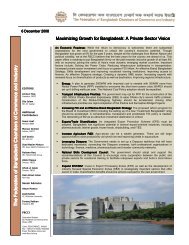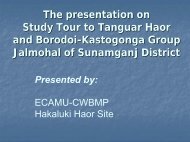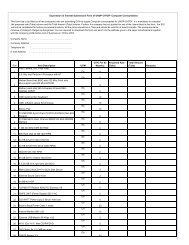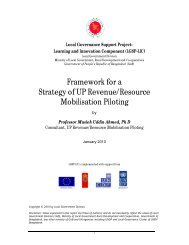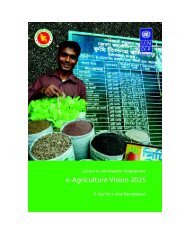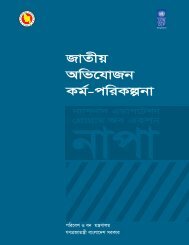The probable impacts of climate change on poverty - UNDP
The probable impacts of climate change on poverty - UNDP
The probable impacts of climate change on poverty - UNDP
Create successful ePaper yourself
Turn your PDF publications into a flip-book with our unique Google optimized e-Paper software.
Table 5.12 Drought Affected Area<br />
1791<br />
Year % <str<strong>on</strong>g>of</str<strong>on</strong>g> affected area<br />
1951 31.63%<br />
1957 46.54%<br />
1958 37.47%<br />
1961 22.39%<br />
1966 18.42%<br />
1972 42.48%<br />
1979 42.04%<br />
1865 Drought proceeding famine occurred in Dhaka.<br />
1866 Severe drought in Bogra. <str<strong>on</strong>g>The</str<strong>on</strong>g> rice producti<strong>on</strong> <str<strong>on</strong>g>of</str<strong>on</strong>g> the district was hit hard and the price went<br />
up three times its normal level.<br />
1872 Drought in Sundarbans. <str<strong>on</strong>g>The</str<strong>on</strong>g> rainfall was deficient and in several lots the crops sufferedto a<br />
great extent.<br />
1874 Bogra was affected and the crop failure was much greater. <str<strong>on</strong>g>The</str<strong>on</strong>g> rainfall was extremely low.<br />
1951 Severe drought in northwest Bangladesh and substantially reduced rice producti<strong>on</strong>.<br />
1973 One <str<strong>on</strong>g>of</str<strong>on</strong>g> the severest in the present century and was resp<strong>on</strong>sible for the 1974 famine in<br />
northern Bangladesh.<br />
1975 This drought affected 47% <str<strong>on</strong>g>of</str<strong>on</strong>g> the entire country and caused sufferings to about 53% <str<strong>on</strong>g>of</str<strong>on</strong>g> the<br />
total populati<strong>on</strong>.<br />
1978 -79 Severe drought causing widespread damage to crops. Reduced rice producti<strong>on</strong> by about 2<br />
milli<strong>on</strong> t<strong>on</strong>s and directly affected about 42% <str<strong>on</strong>g>of</str<strong>on</strong>g> the cultivated land and 44% <str<strong>on</strong>g>of</str<strong>on</strong>g> the<br />
populati<strong>on</strong>. It was <strong>on</strong>e <str<strong>on</strong>g>of</str<strong>on</strong>g> the severest in recent times.<br />
1981 Severe drought adversely affected crop producti<strong>on</strong>.<br />
1982 Caused a total loss <str<strong>on</strong>g>of</str<strong>on</strong>g> rice producti<strong>on</strong> amounting to about 53,000 t<strong>on</strong>s. In the same year<br />
flood damaged about 36,000 t<strong>on</strong>s <str<strong>on</strong>g>of</str<strong>on</strong>g> rice.<br />
1989 Most <str<strong>on</strong>g>of</str<strong>on</strong>g> the rivers in NW Bangladesh dried up and in several districts, such as Naoga<strong>on</strong>,<br />
Nawabganj, Nilpahamari and Thakurga<strong>on</strong>; dust syndrome occurred for a prol<strong>on</strong>ged period<br />
due to drying up the topsoil.<br />
1994 -95 This drought was followed by that <str<strong>on</strong>g>of</str<strong>on</strong>g> 1995-96, caused immense damage to crops, especially<br />
in the case <str<strong>on</strong>g>of</str<strong>on</strong>g> rice and jute the main crops <str<strong>on</strong>g>of</str<strong>on</strong>g> NW Bangladesh. <str<strong>on</strong>g>The</str<strong>on</strong>g>se are followed by<br />
bamboo-clumps, a major cash earning crop <str<strong>on</strong>g>of</str<strong>on</strong>g> many farmers in the regi<strong>on</strong>. In the recent<br />
times, this was most persistent drought in Bangladesh.<br />
<str<strong>on</strong>g>The</str<strong>on</strong>g> Probable Impacts <str<strong>on</strong>g>of</str<strong>on</strong>g> Climate Change <strong>on</strong> Poverty and Ec<strong>on</strong>omic Growth and<br />
the Opti<strong>on</strong>s <str<strong>on</strong>g>of</str<strong>on</strong>g> Coping with adverse Effect <str<strong>on</strong>g>of</str<strong>on</strong>g> Climate Change in Bangladesh<br />
Table 5.13 Frequency <str<strong>on</strong>g>of</str<strong>on</strong>g> Occurrence <str<strong>on</strong>g>of</str<strong>on</strong>g> Drough<br />
District Frequency<br />
Panchagar<br />
Thakurga<strong>on</strong><br />
Jessore 1<br />
Naoga<strong>on</strong> 5<br />
Nawabganj 5<br />
Rajshahi 1<br />
Natore 1<br />
Nilpahamari 1<br />
Joypurhat 3<br />
Dinajpur 3<br />
Rangpur 3<br />
Pabna 1<br />
Bogra 1<br />
Table 5.14 Showing historical significance <str<strong>on</strong>g>of</str<strong>on</strong>g> droughts<br />
Drought affected Jessore district. Priceshad risen twice and three times <str<strong>on</strong>g>of</str<strong>on</strong>g> their usual levels.<br />
1<br />
1<br />
37




